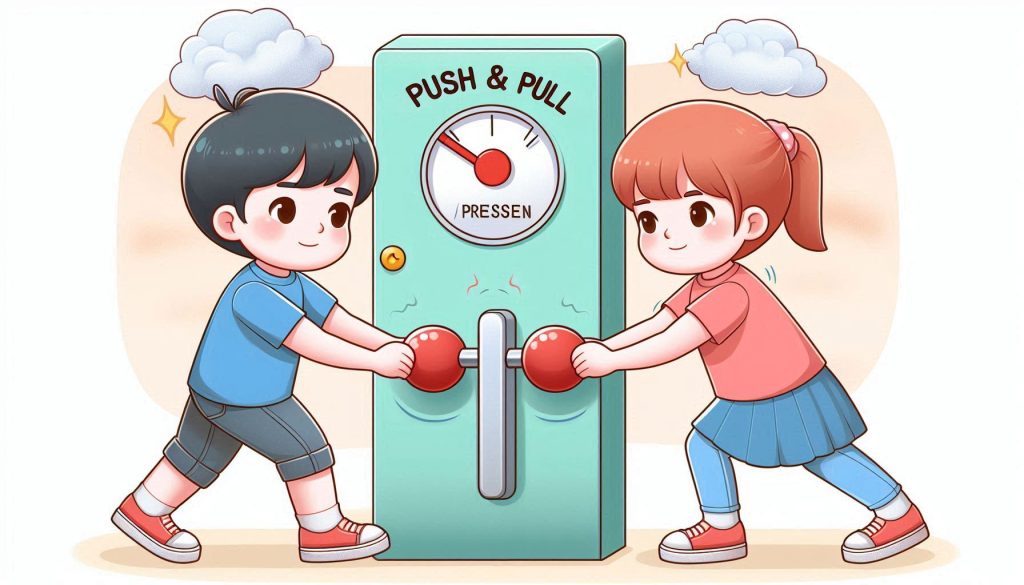Force and Pressure – Complete Guide For Class 8 Science Chapter 8
Welcome to iPrep, your Learning Super App! Our learning resources for the chapter, Force and Pressure Class 8th chapter 8 are designed to ensure that you grasp this concept with clarity and perfection. Whether you’re studying for an upcoming exam or strengthening your concepts, our engaging animated videos, practice questions and notes offer you the best of integrated learning with interesting explanations and examples.
The chapter on Force and Pressure in Class 8 Science introduces students to the essential concepts of force and pressure, laying the groundwork for understanding how these forces influence the physical world. It explains how forces can cause objects to move, change direction, alter speed, and modify shape and size. The topic categorizes forces into contact and non-contact forces, providing real-world examples such as the push or pull required to move objects and the gravitational pull that keeps us grounded. Additionally, it delves into the concept of pressure, highlighting how force is distributed over an area and how this affects liquids, gases, and atmospheric pressure. By exploring the principles of force and pressure, students gain a deeper understanding of the mechanics that govern everyday phenomena.

What Can a Force Do?
A force is an influence that can cause an object to undergo changes in motion or shape. Here are some effects of force:
- Causes Movement: Forces can set objects in motion.
- Changes Speed: They can accelerate or decelerate an object.
- Changes in Direction of Motion: Forces can alter the path of an object.
- Changes in Shape and Size of Objects: Forces can deform objects by compressing or stretching them.
Categories of Force
Forces can be classified broadly into two categories:
- Push: Applying a force to move an object away, like pushing a box.
- Pull: Applying a force to draw an object closer, like opening a door.
Characteristics of Force
According to the chapter force and pressure a force has two main characteristics:
- Magnitude: Refers to the strength or size of the force applied, such as when you push a moving bicycle.
- Direction: The line along which a force acts, such as when a batsman hits a ball in a specific direction.
Condition for a Force to Act
it is stated in the chapter force and pressure that for a force to act, there must be at least two objects involved. A single object cannot exert a force by itself. For instance, Rohan can only kick a ball if both Rohan and the ball are present.
Nature of Force
When multiple forces are applied to an object:
- In the Same Direction: They add up.
- In Opposite Directions: They subtract from each other.
Changing the State of an Object
The state of an object can be changed by altering its motion:
- State of Motion: An object can be either at rest or in motion.
- Change Due to Force: A force can change the speed or direction of an object, thus altering its state of motion.
Types of Forces
Within the chapter force and pressure, Forces are broadly divided into two types:
Contact Forces
These forces require physical contact between objects.
- Muscular Force: Produced by muscles.
- Frictional Force: Acts against the motion of an object.
Non-contact Forces
These forces do not require physical contact.
- Magnetic Force: Acts between magnets or magnets and iron objects.
- Electrostatic Force: Acts between charged objects.

- Gravitational Force: Acts between any two masses, like the Earth pulling objects toward it.

Understanding Pressure
Pressure is the force applied per unit area. It is expressed as:
Pressure = Force / Area
This formula indicates that force and pressure increase with greater force and decrease when the force is spread over a larger area. Pressure is measured in units such as Pascals (Pa), where 1 Pascal equals 1 Newton per square meter (N/m²).
Pressure in Liquids and Gases
- Liquids: Exert pressure on the walls of their container.

- Gases: Exert pressure in all directions within their container.

Atmospheric Pressure

Atmospheric pressure is the force exerted by the weight of the Earth’s atmosphere on every surface it touches, resulting from the gravitational pull on the air molecules. It is an essential concept for understanding weather patterns, as variations in atmospheric pressure are closely linked to changes in weather. High-pressure areas typically lead to clear, calm conditions, while low-pressure systems can bring storms and rain. Atmospheric pressure also affects altitude-related phenomena, such as the boiling point of water and the function of barometers, which are used to measure pressure changes and forecast weather. Understanding atmospheric pressure is crucial for fields such as meteorology, aviation, and even human physiology, as it influences breathing and oxygen availability at different altitudes.
This comprehensive guide on the concepts of force and pressure forms the foundation for understanding how these forces interact in the natural world, influencing everything from simple daily activities to complex scientific phenomena. By exploring how forces can cause movement, change direction, and alter the shape of objects, students gain insight into the fundamental principles governing physical interactions. Pressure plays a key role in understanding everyday phenomena such as why sharp knives are more effective at cutting and how hydraulic systems function. These principles are fundamental to grasping the underlying concepts in fields like engineering, meteorology, and various technologies that depend on the manipulation and control of forces and pressures. By applying these concepts, we can innovate and solve practical challenges across different domains. Understanding these interactions not only enriches our knowledge of the physical world but also empowers us to harness these forces in innovative ways to solve practical problems.
Practice questions on Chapter 8 - Force And Pressure
Get your free Chapter 8 - Force And Pressure practice quiz of 20+ questions & detailed solutions
Practice Now








